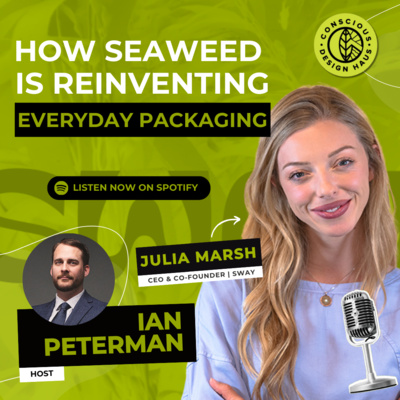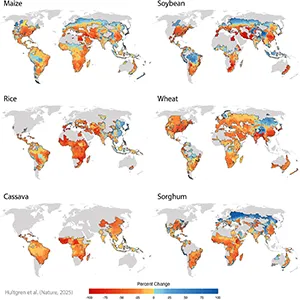Seaweed – The Superfood Tackling Health Emissions And Food Security – Forbes

Report on the Role of Seaweed in Global Sustainability and Health
Seaweed, a fast-growing marine macroalgae, is emerging as a critical resource in addressing global challenges such as rising chronic disease and climate instability. Its application has expanded from traditional coastal cuisines to a wide range of products including dietary supplements, bioplastics, and methane-reducing livestock feed. This report outlines the potential of seaweed cultivation to support global food security and climate objectives, with a significant focus on its alignment with the United Nations Sustainable Development Goals (SDGs).
Contribution to Sustainable Development Goals (SDGs)
The cultivation and utilization of seaweed directly support numerous SDGs, positioning it as a key component of a sustainable future. Its minimal resource requirements—no land, freshwater, or fertilizers—make it one of the most sustainable crops available.
SDG 2: Zero Hunger
Seaweed cultivation offers a viable path to enhancing global food security. Research by institutions including the University of Queensland and the International Institute for Applied Systems Analysis indicates that scaling up seaweed farming can significantly reduce pressure on terrestrial agriculture, providing a sustainable source of food and materials without expanding land use.
SDG 3: Good Health and Well-being
Seaweed provides essential nutrients often lacking in modern Western diets, which contribute to chronic health issues. Its rich composition helps address these deficiencies and promotes overall well-being.
- It is a potent source of insoluble fibers like fucoidan, beta-glucan, and alginate.
- Fermentation of these fibers by gut bacteria produces short-chain fatty acids, which are linked to improved insulin sensitivity, satiety, and immune function.
SDG 13: Climate Action
Seaweed plays a direct role in climate change mitigation through two primary mechanisms:
- Carbon Sequestration: As it grows, seaweed absorbs significant amounts of CO₂ from the atmosphere.
- Methane Reduction: Companies like FutureFeed have developed seaweed-based cattle feed supplements that have been shown to reduce methane emissions from livestock by over 80%, directly tackling a major source of greenhouse gases.
SDG 14: Life Below Water
Seaweed farming contributes positively to marine ecosystems. It helps de-acidify the ocean by absorbing CO₂, absorbs excess nitrogen runoff, and can increase local marine biodiversity by creating new habitats.
SDG 12: Responsible Consumption and Production
As a raw material, seaweed supports a circular economy. Its use in creating biodegradable bioplastics presents a sustainable alternative to petroleum-based plastics, promoting more responsible production and consumption patterns.
Industry Innovation and Commercial Applications
Biotech and agritech companies are pioneering the use of seaweed in innovative products that support both human health and planetary stewardship.
Case Study: OCEANIUM
UK-based biotech firm OCEANIUM is leveraging seaweed to create high-value products. Key initiatives include:
- OCEAN ACTIVES® H+: A flagship ingredient clinically proven to improve the gut microbiome by increasing beneficial Bifidobacterium.
- Green Biorefinery Process: A proprietary method ensuring ingredients are bioavailable, safe, and fully traceable.
- Research Collaboration: The company is engaged in research with Wageningen University on dementia prevention via the gut-brain axis and with Reading University on human and pet nutrition.
Other Industry Leaders
Innovation in the seaweed sector is global. Australian companies PhycoHealth and FutureFeed are notable for their contributions to health supplements and climate-friendly agriculture, respectively, further demonstrating the versatile application of seaweed in achieving the SDGs.
Challenges and Strategic Way Forward
Despite its vast potential, the mainstream adoption of seaweed faces several hurdles that require strategic solutions.
Current Obstacles
- Processing Infrastructure: A lack of scaled processing facilities creates a bottleneck for large-scale production.
- Consumer Palatability: The distinct taste and texture of seaweed can be a barrier for some consumers.
Proposed Solutions
Overcoming these challenges requires a multi-pronged approach focused on product development and consumer engagement.
- Ingredient Innovation: Refining seaweed into versatile, neutral-flavored ingredients that can be seamlessly integrated into familiar foods like snacks, soups, and protein bars.
- Consumer Education: Building trust and encouraging adoption by clearly communicating the health benefits and significant sustainability value of seaweed, thereby aligning it with consumer values.
Conclusion: Seaweed as a Frontier Crop for a Sustainable Future
Seaweed represents a rare convergence of health, climate, and economic opportunity. Supported by scientific research and driven by innovation, it is a frontier crop with the capacity to nourish populations and regenerate planetary systems. By addressing current challenges through strategic partnerships, processing advancements, and public education, seaweed can transition from a niche ingredient to a mainstream force in global food systems, the bioeconomy, and environmental resilience. Its cultivation and use are fundamentally aligned with the Sustainable Development Goals, offering a tangible pathway toward a more sustainable and healthy future.
Analysis of Sustainable Development Goals in the Article
1. Which SDGs are addressed or connected to the issues highlighted in the article?
The article on seaweed’s potential addresses several UN Sustainable Development Goals (SDGs) by highlighting its role in health, climate, and sustainable production. The company OCEANIUM is explicitly mentioned as supporting six SDGs. Based on the text, the following goals are the most relevant:
- SDG 2: Zero Hunger – The article discusses how seaweed can “help meet global food and material demands” and support “food security” without expanding agricultural land.
- SDG 3: Good Health and Well-being – A significant portion of the article focuses on seaweed’s health benefits, such as combating “rising chronic disease,” improving gut health, and its potential in dementia prevention.
- SDG 9: Industry, Innovation, and Infrastructure – The text highlights innovation in the seaweed industry, including “green biorefinery process,” the development of new products like bioplastics and supplements, and the need for better “processing infrastructure.”
- SDG 12: Responsible Consumption and Production – Seaweed is presented as a model for sustainable production as it “requires no land, freshwater, or fertilizer.” Its use in creating “bioplastics” also points to more responsible consumption patterns.
- SDG 13: Climate Action – The article directly connects seaweed to climate solutions, noting its ability to absorb “CO₂” and the development of a cattle feed supplement that “cuts methane emissions by over 80%.”
- SDG 14: Life Below Water – The cultivation of seaweed is shown to benefit marine ecosystems by absorbing “nitrogen” and increasing “marine biodiversity.” The article stresses the need for “sustainable” management of ocean resources.
2. What specific targets under those SDGs can be identified based on the article’s content?
The article’s content aligns with several specific targets under the identified SDGs:
- Under SDG 2 (Zero Hunger):
- Target 2.1: End hunger and ensure access to safe, nutritious and sufficient food. The article supports this by presenting seaweed as a nutritious food source that can “significantly ease pressure on terrestrial farming” and bolster “food security.”
- Target 2.4: Ensure sustainable food production systems. The article describes seaweed cultivation as one of the “most sustainable crops on Earth” because it requires no land, freshwater, or fertilizer.
- Under SDG 3 (Good Health and Well-being):
- Target 3.4: Reduce by one-third premature mortality from non-communicable diseases. The article highlights how seaweed can address “chronic disease,” “chronic inflammation, and metabolic dysfunction” linked to Western diets.
- Under SDG 9 (Industry, Innovation, and Infrastructure):
- Target 9.5: Enhance scientific research and upgrade technological capabilities. The article is rich with examples, including OCEANIUM’s “proprietary green biorefinery process,” FutureFeed’s methane-reducing supplement, and collaborations with universities on “dementia-prevention research.”
- Under SDG 12 (Responsible Consumption and Production):
- Target 12.2: Achieve the sustainable management and efficient use of natural resources. Seaweed cultivation is presented as an efficient use of marine resources that does not deplete terrestrial ones.
- Target 12.5: Substantially reduce waste generation. The mention of seaweed being used to create “bioplastics” directly relates to this target by offering an alternative to conventional plastic.
- Under SDG 13 (Climate Action):
- Target 13.2: Integrate climate change measures into policies, strategies and planning. The development of a cattle feed that reduces methane emissions is a clear strategy to mitigate climate change.
- Under SDG 14 (Life Below Water):
- Target 14.1: Prevent and significantly reduce marine pollution. Seaweed helps by absorbing “nitrogen,” a common pollutant in coastal waters.
- Target 14.2: Sustainably manage and protect marine and coastal ecosystems. The article states that seaweed cultivation “increases marine biodiversity.”
- Target 14.3: Minimize and address the impacts of ocean acidification. This is addressed through seaweed’s ability to absorb “CO₂” from the water.
3. Are there any indicators mentioned or implied in the article that can be used to measure progress towards the identified targets?
Yes, the article mentions or implies several specific, measurable indicators:
- For SDG 3: A direct indicator is the measured improvement in gut health: “improves the ratio of beneficial to harmful gut bacteria, specifically increasing Bifidobacterium while decreasing Enterobacteriaceae.” The “clinically proven 250 mg dose” is another specific metric.
- For SDG 13: A clear, quantifiable indicator for climate action is the reduction in livestock emissions: the seaweed-based supplement “cuts methane emissions by over 80%.”
- For SDG 14: Indicators for improving marine health include the amount of “CO₂ and nitrogen” absorbed by cultivated seaweed and measured increases in “marine biodiversity” around seaweed farms.
- For SDG 2 & 9: An indicator for progress in sustainable food production and innovation would be the scale of cultivation, which the article implies can be measured (“scaling up the cultivation of commercially valuable seaweed species”). The number of new products developed (e.g., bioplastics, supplements, snacks) also serves as an indicator of innovation.
4. Table of SDGs, Targets, and Indicators
| SDGs | Targets | Indicators |
|---|---|---|
| SDG 2: Zero Hunger | 2.4: Ensure sustainable food production systems. | Cultivation of crops that require “no land, freshwater, or fertilizer.” |
| SDG 3: Good Health and Well-being | 3.4: Reduce mortality from non-communicable diseases. | Improved ratio of beneficial to harmful gut bacteria (increase in Bifidobacterium, decrease in Enterobacteriaceae). |
| SDG 9: Industry, Innovation, and Infrastructure | 9.5: Enhance scientific research and upgrade technological capabilities. | Development of “green biorefinery process” and new products like “bioplastics” and “methane-reducing livestock feed.” |
| SDG 12: Responsible Consumption and Production | 12.5: Substantially reduce waste generation. | Creation of “bioplastics” from seaweed as an alternative to traditional plastics. |
| SDG 13: Climate Action | 13.2: Integrate climate change measures into strategies. | Reduction of methane emissions from cattle by “over 80%” using seaweed-based feed. |
| SDG 14: Life Below Water | 14.1, 14.2, 14.3: Reduce marine pollution, protect ecosystems, and address ocean acidification. | Absorption of “CO₂ and nitrogen” by seaweed; measured “increases marine biodiversity.” |
Source: forbes.com

What is Your Reaction?
 Like
0
Like
0
 Dislike
0
Dislike
0
 Love
0
Love
0
 Funny
0
Funny
0
 Angry
0
Angry
0
 Sad
0
Sad
0
 Wow
0
Wow
0














































































